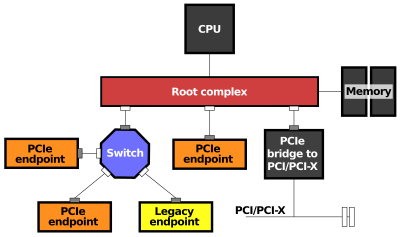Root complex
Appearance
This article needs additional citations for verification. (August 2012) |

In a PCI Express (PCIe) system, a root complex device connects the processor and memory subsystem to the PCI Express switch fabric composed of one or more switch devices.
Similar to a host bridge in a PCI system, the root complex generates transaction requests on behalf of the processor, which is interconnected through a local bus. Root complex functionality may be implemented as a discrete device, or may be integrated with the processor. A root complex may contain more than one PCI Express port and multiple switch devices can be connected to ports on the root complex or cascaded.[2]
References
- ^ Richard Solomon (2015-06-17). "PCI Express Basics and Background" (PDF). PCI-SIG. p. 26. Retrieved 2016-04-12.
- ^ "Choosing the Right Programmable Logic Solution for PCI Express Applications". Retrieved 31 March 2010.
